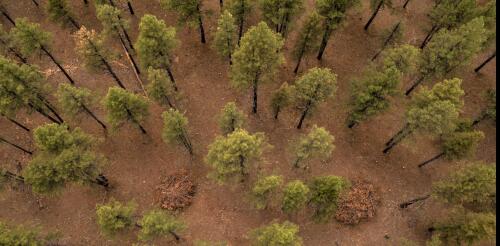Forest thinning
When you walk through a forest, it may feel like a static setting where very little is happening. But trees are constantly interacting and reacting to each other as they grow. There’s intense competition for light and space. Every shift affects the overall makeup of the forest in some way. Forest scientists like me spend a lot of time thinking about forest succession – a predictable process in which plant species colonize and dominate a piece of land. The basic sequence is for land to evolve from an open field to brush and shrubs, then to young trees and ultimately to large, mature trees. Disturbances, such as a major storm or wildfire, can interrupt or set back forest succession. I study ecological changes in species composition, tree arrangement and forest development that occur during succession and after disturbances. My research team analyzes conditions in mixed-species deciduous, or leafy, forests. Using tree rings, we reconstruct what previous forests looked l...
Forests are an essential part of Earth’s operating system. They reduce the buildup of heat-trapping carbon dioxide in the atmosphere from fossil fuel combustion, deforestation and land degradation by 30% each year. This slows global temperature increases and the resulting changes to the climate. In the U.S., forests take up 12% of the nation’s greenhouse gas emissions annually and store the carbon long term in trees and soils. Mature and old-growth forests, with larger trees than younger forests, play an outsized role in accumulating carbon and keeping it out of the atmosphere. These forests are especially resistant to wildfires and other natural disturbances as the climate warms. Most forests in the continental U.S. have been harvested multiple times. Today, just 3.9% of timberlands across the U.S., in public and private hands, are over 100 years old, and most of these areas hold relatively little carbon compared with their potential. The Biden administration is m...
The U.S. government is investing over US$7 billion in the coming years to try to manage the nation’s escalating wildfire crisis. That includes a commitment to treat at least 60 million acres in the next 10 years by expanding forest-thinning efforts and controlled burns. While that sounds like a lot – 60 million acres is about the size of Wyoming – it’s nowhere close to enough to treat every acre that needs it. So, where can taxpayers get the biggest bang for the buck? I’m a fire ecologist in Montana. In a new study, my colleagues and I mapped out where forest treatments can do the most to simultaneously protect communities – by preventing wildfires from turning into disasters – and also protect the forests and the climate we rely on, by keeping carbon out of the atmosphere and stored in healthy soils and trees. Wildfires are becoming more severe Forests and fires have always been intertwined in the West. Fires in dry conifer forests...
Forests are critically important for slowing climate change. They remove huge quantities of carbon dioxide from the atmosphere – 30% of all fossil fuel emissions annually – and store carbon in trees and soils. Old and mature forests are especially important: They handle droughts, storms and wildfires better than young trees, and they store more carbon. In a 2022 executive order, President Joe Biden called for conserving mature and old-growth forests on federal lands. Recently Biden protected nearly half of the Tongass National Forest in Alaska from road-building and logging. The Biden administration is compiling an inventory of mature and old-growth forests on public lands that will support further conservation actions. But at the same time, federal agencies are initiating and implementing numerous logging projects in mature and old forests without accounting for how these projects will affect climate change or forest species. As scientists who have spent decades...



